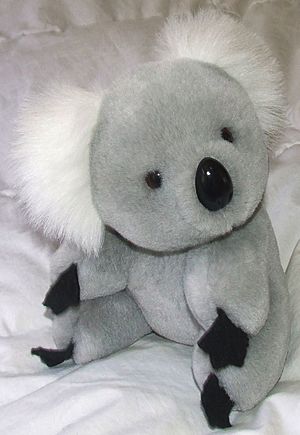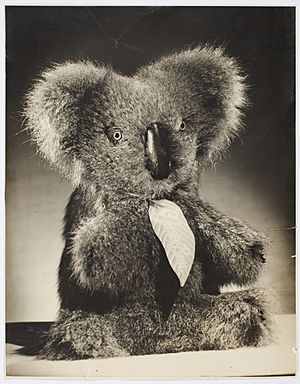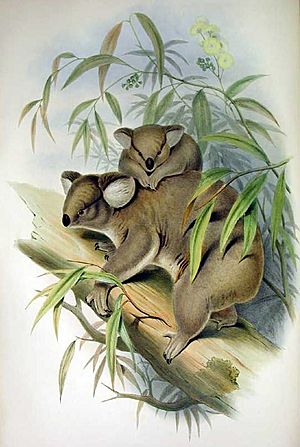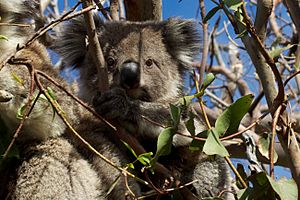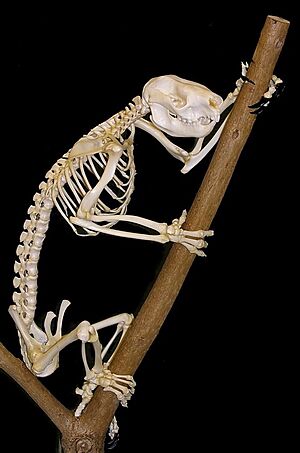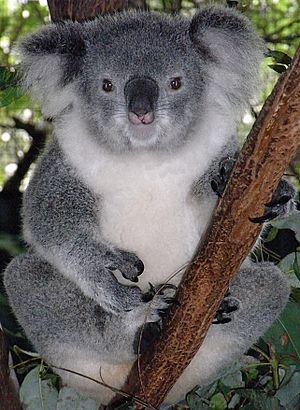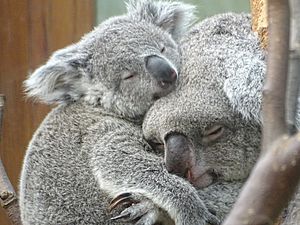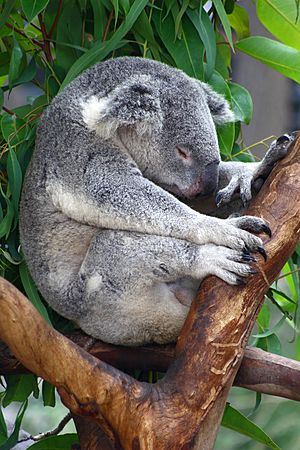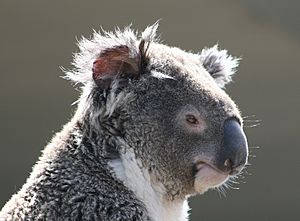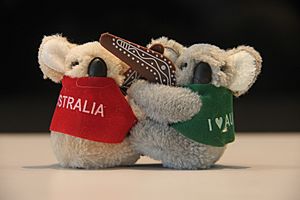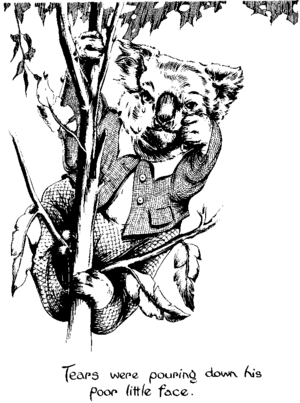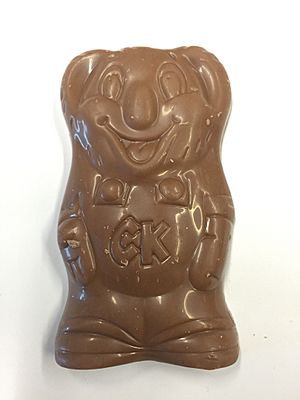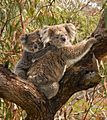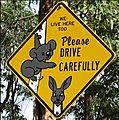Koala facts for kids
Quick facts for kids Koala |
|
|---|---|
 |
|
| Conservation status | |
| Scientific classification | |
| Genus: |
Phascolarctos
|
| Species: |
cinereus
|
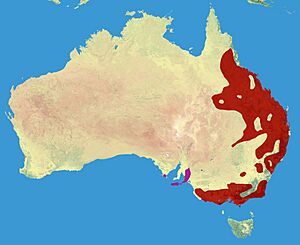 |
|
| Koala range
Native Introduced |
|
| Synonyms | |
The koala is a special animal from Australia. Some people call it a 'koala bear', but that's not quite right! Koalas are actually marsupials, like kangaroos, not bears. They are the only living members of their animal family. Their closest relatives are wombats.
Koalas live in the eastern and southern parts of Australia. You can find them in Queensland, New South Wales, Victoria, and South Australia. They are easy to spot with their strong, tailless bodies and big heads. They have round, fluffy ears and a large, spoon-shaped nose. Koalas are about 60 to 85 cm long and weigh between 4 and 15 kg. Their fur can be silver-grey to chocolate brown. Koalas from the north are usually smaller and lighter in color than those from the south.
Koalas mostly live in open eucalyptus forests. They eat almost only eucalyptus leaves. These leaves don't have much energy or nutrition. So, koalas are very sleepy and rest for up to 20 hours a day! They usually live alone. Mothers and their babies are the only ones who stay together.
Male koalas make loud bellowing sounds. This helps them scare away other males and find mates. Males also rub their chests on trees to leave their scent. This shows other koalas they are there. Like all marsupials, koalas give birth to tiny, undeveloped babies. These babies, called joeys, crawl into their mother's pouch. They stay there for about six to seven months. Joeys stop drinking milk when they are about a year old.
Koalas don't have many natural enemies. But they can get sick from bacteria and viruses. They are also in danger from bushfires and dry weather. In the past, many koalas were hunted for their fur. This led to people wanting to protect them. Now, there are special places called sanctuaries for koalas. Efforts are also made to move koalas to new areas if their homes are broken up or too small.
The koala is not an endangered species, but it is a vulnerable species. This means their numbers are going down.
Contents
What's in a Name?
The word "koala" comes from the Dharug word gula. This word means "no water". Early settlers thought koalas didn't drink water because they get most of it from eucalyptus leaves.
People also called koalas "native bears" or "koala bears". This was because they looked a bit like bears. The scientific name for the koala's group is Phascolarctos. This name comes from Greek words. Phaskolos means "pouch" and arktos means "bear".
Koala History
Indigenous Australians hunted koalas for thousands of years. They also drew them in cave art and told stories about them. In some myths, the koala helped people travel or created bridges. Some tribes thought koalas were wise animals and asked them for advice.
Europeans first saw a koala in 1798. A scientist named Robert Brown wrote the first detailed description of the koala in 1814.
After World War II, more tourists came to Australia. Koalas were also sent to zoos around the world. This made them even more popular. Many famous people have had their pictures taken with koalas. These include Queen Elizabeth II, Pope John Paul II, and US President Bill Clinton.
What do they look like?
The koala is a strong animal with a big head. It has a very short tail, or sometimes no tail at all. They are among the largest marsupials that live in trees. Koalas from Victoria can be twice as heavy as those from Queensland. Males are also about 50% larger than females. Males have more curved noses and scent glands on their chests.
Koalas have thick fur on their backs. This fur can be light grey to chocolate brown. Their belly fur is whitish. This fur helps keep them warm and dry in the rain. It also protects them from the sun.
Their claws are sharp and curved, perfect for climbing trees. Their front paws have two thumbs that help them grip branches. On their back paws, two toes are joined together. These claws act like a comb for grooming. Koalas have strong bones and muscles, especially in their upper bodies. This helps them climb well.
Koalas have a broad, dark nose with an excellent sense of smell. They use it to sniff eucalyptus leaves to find the best ones to eat. Their eyes are small, with vertical pupils. This helps them see better in trees. Their round ears give them good hearing.
Koalas have special teeth for their diet. They have sharp front teeth (incisors) and strong back teeth (molars). A big gap separates these teeth. They use their incisors to bite leaves. Then they use their molars to grind them into tiny pieces. Sometimes, they store food in their cheek pouches.
Their digestive system is also unique. They are "hindgut fermenters." This means they digest food in their large intestine, called a caecum. Their caecum is very long, about 200 cm! This allows them to break down tough eucalyptus leaves. Koalas have a slow metabolism. This helps them save energy from their low-nutrient diet. Their liver can also break down the toxic chemicals in eucalyptus leaves. They get most of their water from leaves, so they don't need to drink often.
Koala Life Cycle
Koalas are mostly active at night. They live in trees and rarely come down to the ground. They eat leaves from Eucalyptus trees. Koalas don't drink water often. They get most of their water from the eucalyptus leaves they eat.
Koalas usually live alone. But they do have a social order with other koalas living nearby. Because their diet gives them little energy, koalas must save their energy. They sleep or rest for about 20 hours a day. They spend only about 4 hours a day moving around. They are most active at night when they are feeding. They often eat and sleep in the same tree for a whole day.
On warm days, a koala might rest with its back against a branch. It might also lie on its stomach or back with its arms and legs hanging down. When it's cold and wet, it curls up tight to stay warm. On windy days, a koala finds a lower, thicker branch to rest on. Even though they spend most of their time in trees, they do come down. They walk on all fours to move to another tree.
Koalas usually clean themselves with their back paws. Sometimes they use their front paws or mouth.
A baby koala is born after about 35 days. It is only about a quarter of an inch long. It has no ears, eyes, or hair. The tiny baby crawls into its mother's pouch by itself. After 12 months, the young koala is old enough to leave the pouch. It also stops drinking milk. Then, the female koala can have another baby.
Young koalas usually leave their mothers when they are 18 months old. But if their mother doesn't have another baby, they might stay for up to three years. Koalas become adults when they are about two years old. But they often have their first baby after another two years.
Health and Dangers
Koalas can live from 13 to 18 years in the wild. Female koalas usually live this long. But males might die sooner because their lives are more dangerous. Koalas often survive falls from trees and climb right back up. But sometimes, falls can cause injuries or even death. This is more common for young koalas or males fighting. Around six years old, a koala's chewing teeth start to wear down. This makes it harder for them to chew their food. Eventually, they can't chew at all and may die from not being able to eat.
Koalas have few natural enemies. Dingos and large pythons might hunt them. Large birds of prey, like powerful owls and wedge-tailed eagles, can be a threat to young koalas. Koalas usually don't have many external parasites, except for ticks in some areas. Internal parasites are rare and usually don't cause harm.
Koalas can get sick from bacteria called Chlamydiaceae. This can cause eye infections, bladder infections, and problems with reproduction. These infections are common on the mainland. But some island koala groups don't have them. The koala retrovirus (KoRV) can cause a sickness like AIDS in humans. This virus is spreading from northern to southern Australia. All koalas in the north are infected. But some southern groups, like those on Kangaroo Island, are free of the virus.
Koalas are in danger from bushfires. They move slowly, and eucalyptus trees burn easily. Koalas try to hide in higher branches, but this makes them vulnerable to intense heat and flames. Bushfires also break up their homes. This makes it hard for koalas to move around. It also leads to fewer koalas and less variety in their genes.
Not having enough water and getting too hot can also kill koalas. So, koalas are affected by climate change. Droughts also harm koalas. For example, a bad drought in 1980 made many eucalyptus trees lose their leaves. Because of this, 63% of the koalas in southwest Queensland died. It took a long time for their numbers to grow back.
Later, the koala population in that area dropped even more. This was because of hotter and drier weather from droughts between 2002 and 2007. Another problem from climate change is how more carbon dioxide in the air affects eucalyptus trees. It makes their leaves have less protein and more tannins. This means the koalas' food is not as good for them.
Koalas in Culture
The koala is famous worldwide. It helps bring many visitors to Australian zoos and wildlife parks. Koalas have been in ads, games, cartoons, and are popular as soft toys. In 1998, they brought in over a billion Australian dollars for tourism. This number has grown since then. Many tourists, especially from Korea, Japan, and Taiwan, want to see koalas when they visit Australia.
Early European settlers first thought koalas looked fierce. But in the early 1900s, koalas became more popular. This was thanks to children's stories. Perhaps the most famous koala character is Blinky Bill. He was created in 1933 by Dorothy Wall. Blinky Bill has been in books, movies, TV shows, and even a song.
The first Australian stamp with a koala came out in 1930. The Australian airline Qantas had a famous TV ad campaign. It started in 1967 and featured a live koala. This ad series is known as one of the best commercials ever.
A song called "Ode to a Koala Bear" was on the B-side of the 1983 song "Say Say Say" by Paul McCartney and Michael Jackson. Koalas were also main characters in cartoons like The Kwicky Koala Show and Noozles in the 1980s.
There are food items shaped like koalas. These include the Caramello Koala chocolate bar and the cookie snack Koala's March. In Victoria, there's a tourist center shaped like a giant koala. The Queensland Reds rugby team has a koala as its mascot. The Australian Platinum Koala coin shows the koala on one side and Queen Elizabeth II on the other.
Interesting facts about the koala
- Koalas are known all over the world as a symbol of Australia.
- The word 'koala' was at first spelled like "coola" or "koolah".
- The species name, cinereus, is Latin for "ash colored".
- Many stories explain why the koala lost its tail. In one of them, a kangaroo cut it off because the koala was lazy.
- The first picture of a koala was published in 1810 by George Perry.
- The first living koala arrived in Britain in 1881.
- Koalas have fingerprints, just like humans! It can be hard for experts to tell if a fingerprint is from a human or a koala. Fingerprints are rare for tree-climbing mammals.
- Koalas have a small brain for their body size. It is about 60% smaller than other similar animals. Their small brain might be due to their low-energy diet. This diet doesn't provide enough energy for a larger brain.
- Experts think there are only about 50,000 koalas left in the wild.
- The drop bear is a made-up creature in Australian stories. It's a scary, meat-eating version of a koala. This fake animal is often talked about in tall tales to scare tourists.
Images for kids
-
US President Barack Obama with a koala in Brisbane, Australia
See also
 In Spanish: Koala para niños
In Spanish: Koala para niños



